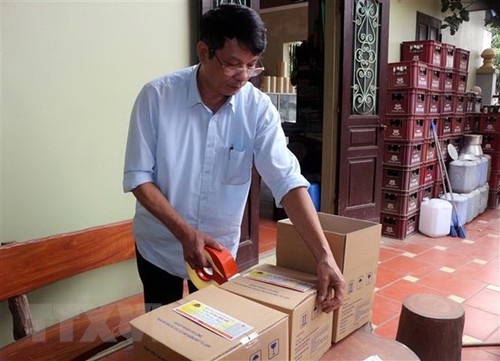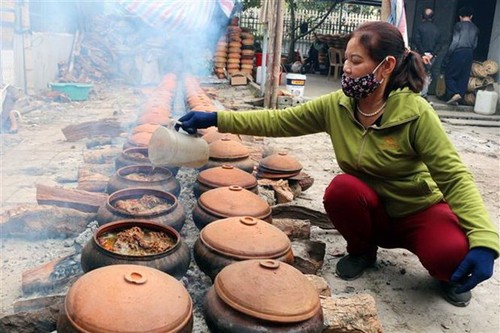The name Nhan Hau is associated with this special New Year treat. The braised fish is shipped to other parts of Vietnam and overseas. In Nhan Hau village, seven companies and hundreds of households produce braised fish, yielding tens of thousands of pots for domestic and foreign markets.
Tran Xuan Thuc, chairman of the Nhan Hau Braised Fish Production and Trading Association, said, “Braising fish is an age-old tradition. We used to braise fish just for relatives and friends. Now we also earn money from it. My family started braising fish 20 years ago.”
 Mr. Thuc labels traceability stamps on his braised fish pots. (Photo: VNA) Mr. Thuc labels traceability stamps on his braised fish pots. (Photo: VNA) |
The ingredients for Nhan Hau braised fish are ubiquitous in Vietnam’s rural areas: ginger, galangal, lime, and star fruit. Black carps are caught, scaled, washed, and cut into pieces. Ginger and galangal are crushed. Star fruits are sliced. It’s best to braise fish in clay pots to retain the flavor.
Tran Ba Toan, owner of the Toan Huong braised fish factory, said, “We have a secret method for making Nhan Hau braised fish distinctively flavorful. We carefully select large live fish, which have not been fed industrial processed food. We don’t cut the fish into pieces until after we have scaled and washed them to keep their sweet taste from being washed away. All the spices – ginger, galangal, chili, and lime juice – are carefully prepared, too. The recipe varies a little bit depending on the pot size and the preference of different regions. We add more sugar for southern customers. Customers in the central region prefer the flavor to be spicier.”
A layer of crushed ginger, galangal, chili, and lemon grass is placed into the bottom of the clay pot. Then the fish is put in, with another layer of ginger and galangal on top. The fish may be mixed with pork ribs or pork belly for a fattier taste. It’s best to braise the fish using longan firewood.
Chairman Thuc of the Nhan Hau Braised Fish Production and Trading Association said, “Smoke from burning longan wood doesn’t produce any smell that might interfere with that of the braised fish. The wood is highly combustible. Even when the flame is out, the charcoal remains hot for a long while.”
It takes approximately 12 hours to complete the cooking. The fish is braised until a spoonful of water is left inside the pot.
Toan of the Toan Huong factory revealed the secret of perfectly braised fish, “The pots are placed on the stove when the fire is burning hottest so the fish pots will boil as soon as possible. Then we extinguish the fire and simmer the fish gently for up to 12 hours. If the fish becomes scorched, it is thrown away.”
 Tens of thousands of pots are sold for domestic and foreign markets during Tet. (Photo: VNA) Tens of thousands of pots are sold for domestic and foreign markets during Tet. (Photo: VNA) |
As Tet draws near, Nhan Hau villagers get very busy braising fish for sale. At the Toan Huong factory, owner Toan is braising 1,500 fish pots. To prepare for this, Toan ordered black carps and seasonings at the beginning of the year. He traveled from Ha Nam to Nghe An to buy clay pots which are of medium thickness and really heat-resistant, ideal for braised fish.
Toan told VOV, “We stocked up on longan firewood long before Tet. The wood was cut and dried out so it will burn easily. We have stored 30 tons of longan firewood.”
For years, Nhan Hau braised fish has been sealed in vacuum bags to retain its freshness and flavor.